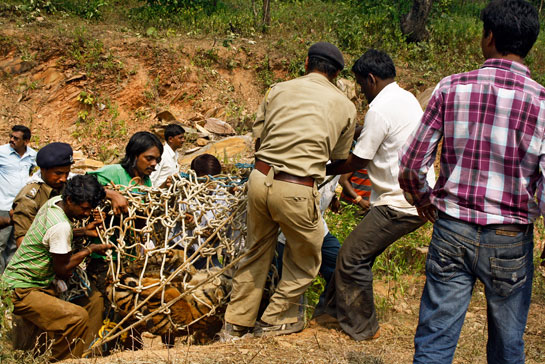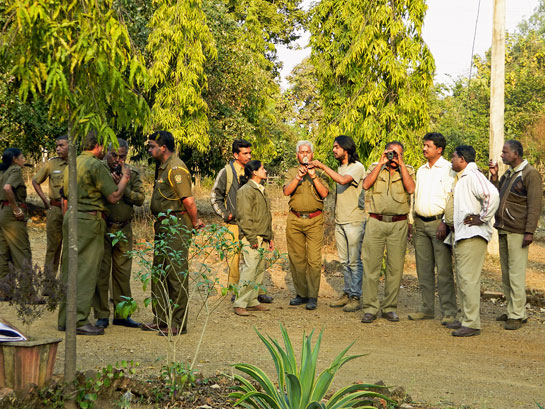The Wildlife Conservation And Development Centre
Author:
First published in Sanctuary Asia,
Vol. 33
No. 9,
September 2013
 Photo Courtesy: Roheet P. Karoo/WLCDC.
Photo Courtesy: Roheet P. Karoo/WLCDC.
In the very first year, members identified Umred-Karhandla as an area with an excellent source population of tigers. Though the prey base was sparse, they believed that the area held great potential to become a productive sanctuary for wildlife if protected. Within six months, following some hard lobbying and efforts, their proposal to declare the area as a wildlife sanctuary was accepted and the area was notified by the government.
Since then, WLCDC has been working to strengthen protection and has been assisting the Forest Department in monitoring tigers, mitigating man-animal conflict and managing tourism. The sanctuary has now become very popular among wildlife enthusiasts in Nagpur. WLCDC is playing a pro-active role in training village youth as guides, which is helping employ locals and turn them into tiger supporters.
The organisation also collaborates with the Wildlife Protection Society of India (WPSI) to conduct anti-poaching activities. “We have implemented WPSIs Secret Information Reward Scheme in the area to gather information about wildlife crimes and have generated several intelligence inputs," Karoo informed Sanctuary Asia. “Team members often assist the Forest Department, police and WPSI in keeping a tab on suspects and conducting surveillance in places frequented by organised poaching groups," he adds.
One of the key focus areas of WLCDC is monitoring dispersing tigers when they reach the age of roughly two years and over. Karoo, who knows the landscape like the back of his hand, says the number of prey animals in the sanctuary is less, which forces tigers out. This means that sub-adult tigers seeking to establish their own territory move out of the Protected Area. This also leads to greater human-tiger conflict when tigers prey on cattle. “I feel this is going to be one of the major problems in the future. In the past three years, I have monitored more than 200 cases of cattle being killed. This number has to decrease to avoid conflicts in the future and maintain the population of big cats in the area," adds Karoo.
Apart from Karoo, founder members Suhas Bokade, Amol Khobragade, Milind Waghmare, Sonu Mandirkar, Kanhaiya Mandhare, Mayur Waghmare, Hemant Patil, Abijieet Wegad and Karan Mandhre form the efficient team of WLCDC. They are currently assisting the Forest Department in mitigating conflict and rescuing big cats. Efforts are underway to explore more corridors in the Tadoba landscape. The organisation believes that tigers outside reserves need as much protection as given to those inside reserves and cannot be ignored if we wish to secure the future of the tiger.“
Tiger numbers in the Umred-Karhandla Sanctuary have increased thanks to the effective implementation of protection policies. We must involve people in conservation. Giving them due compensation for their losses will ensure their participation in protecting our natural heritage. Poaching is one of the biggest threats to wildlife. Strengthening the anti-poaching network and vigilance is the need of the present and future," says Karoo.
 Photo Courtesy: Roheet P. Karoo/WLCDC.
Photo Courtesy: Roheet P. Karoo/WLCDC.
The Wildlife Conservation Trust (WCT), founded and Chaired by Hemendra Kothari, provides WLCDC with monthly funds to support most of its conservation needs. WPSI is also helping establish this group of dedicated youngsters into a strong anti-poaching network in the Tadoba landscape.
A key objective is to take conservation to the grassroots and mobilise young people at the taluka and village levels. This is a difficult task given the abject poverty in rural areas. “People living in villages near forests depend heavily on its resources. Sometimes out of necessity, often out of greed. Enforcement must go hand in hand with alternative livelihoods. Without addressing this issue all talk of conservation will remain as talk," says Karoo.
For more information, contact: Roheet P. Karoo, Jogithana Peth, Near Sadawarti Temple, Umred (Dist), Nagpur - 441203; Tel.: 919975723342, 917709722022
Author: Anirudh C. Nair, First appeared in: Sanctuary Asia Vol. XXXIII, No. 4, August 2013.


 Photo Courtesy: Roheet P. Karoo/WLCDC.
Photo Courtesy: Roheet P. Karoo/WLCDC. Photo Courtesy: Roheet P. Karoo/WLCDC.
Photo Courtesy: Roheet P. Karoo/WLCDC.